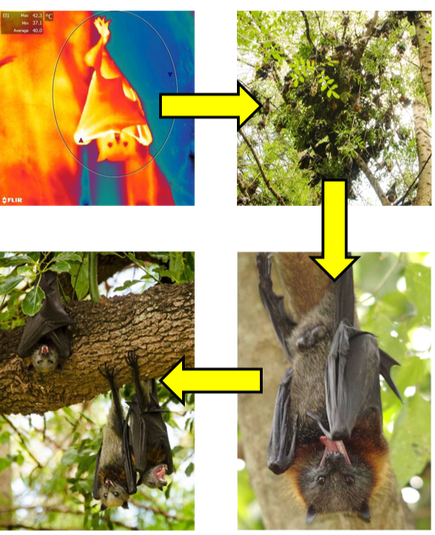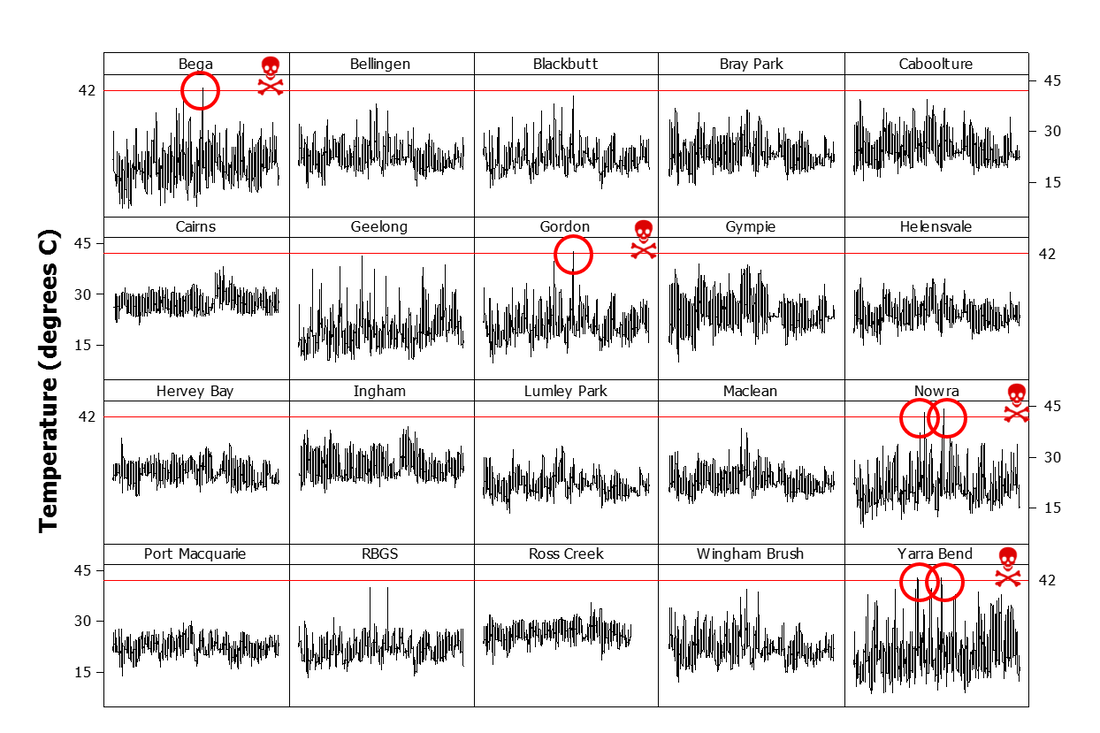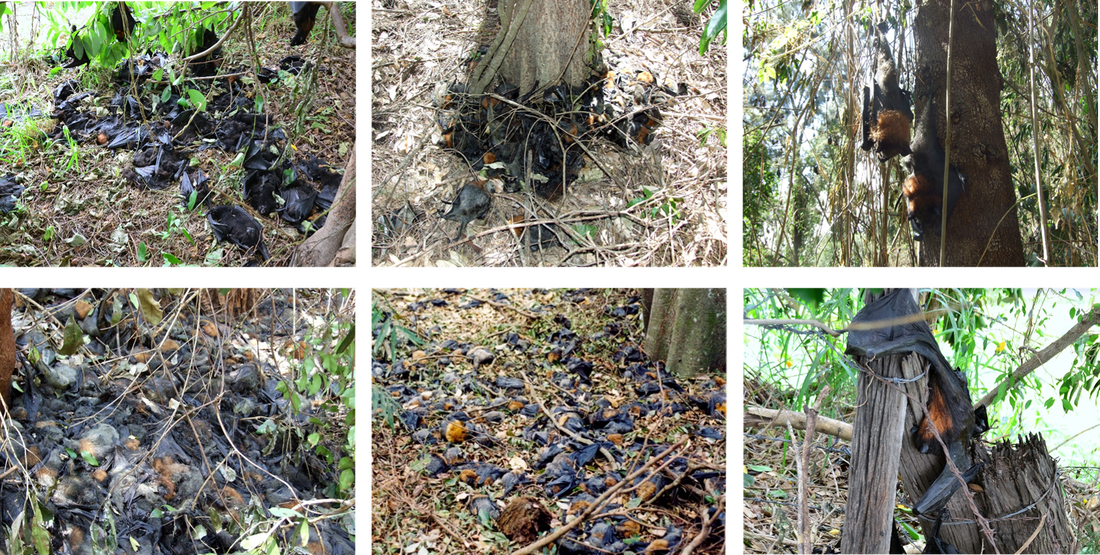Extreme heat events versus flying-foxes: past, present, and future
|
While changes in the long-term mean state of climate are having numerous effects on a range of environmental, social, and economic sectors, many significant impacts of climate change are expected to emerge through shifts in the intensity and the frequency of extreme weather events, including heat waves, droughts, wildfires, and cyclones.
Extreme heat events are of special concern to biodiversity conservation (Hughes et al. 2009), both because of their direct impacts on organismal health, but also because of their effects on water demand and evaporative losses and the frequency and intensity of droughts and wildfires. They can directly result in mass die-offs in wildlife (Welbergen et al 2008) and already contribute significantly to determining which species occur in which ecosystems (Parmesan 2006; Parmesan et al. 2000). Since the frequency, duration and severity of extreme temperature events are rising faster than the means (Easterling et al. 2000; Katz & Brown 1992; Schär et al. 2004; Tebaldi et al. 2006), they will continue to gain significance as mechanistic drivers of ecological responses to climatic change (Kapos et al. 2008). However, despite their clear importance for our understanding of climate change impacts (and hence adaptation action), very little is known about their effects on biodiversity at present.
Flying-foxes are charismatic, large species of bat (weighing up to 1 kg) that forage by night and roost by day in arboreal roosts comprising thousands to tens of thousands of individuals. They provide important ecosystem services, including pollination of wild and cultivated crops and seed dispersal (e.g., Fujita & Tuttle 1991). However, they are exposed to threatening anthropogenic factors (Mickleburgh et al 1992), the most serious of which are loss of foraging and roosting habitat (e.g., Tidemann 1999), direct killing of animals in orchards and harassment and destruction of roosts (e.g., Tidemann & Vardon 1997; Welbergen & Eby 2015).
Our research has shown that temperatures exceeding 42 ºC cause mass mortality among flying-foxes at near biblical scales, with profound effects on the behaviour and ecology of the species. These extreme heat events affect some flying-fox species more than others, with the more tropical black flying-fox (P. alecto) and the spectacled flying-fox (P. conspicillatus) showing higher rates of mortality than the more temperate grey-headed flying-fox (P. poliocephalus). The impacts are also age-class and sex-specific, with dependent young and lactating females predominantly affected during most events.
So far we have collected evidence for at least 48 flying-fox die-off events in Australia, with the earliest dating back to 1791, but the majority occurring since 1994. At least 28 events had a death toll in excess of 1,000. These 28 substantial events resulted in >233,300 casualties, with >200,000 deaths recorded in the last decade alone. This includes one event in January 2014 where about half (45,500) of all black flying-foxes present in South-East Queensland died across 52 roosts during a single hot afternoon; and another event in November 2018 where about one-third (23,000) of all spectacled flying-foxes in Australia died during a dreadful three-day heat event in Far North Queensland. These events are set to escalate under climate change, with disturbing implications for flying-foxes and other wildlife in Australia and beyond. |
Map of Australia showing the maximum temperatures recorded during 'Black Saturday' on 7th February 2009.
Flying-foxes show a predictable sequence of thermoregulatory behaviours with rising temperatures (clockwise: wing fanning, clustering, salivating, panting). Beyond 42º C, thermoregulatory mechanisms become overwhelmed and this is soon followed by death (Welbergen et al 2008).
|
Aims & Objectives
THE OVERARCHING AIM OF THIS RESEARCH IS TO DEVELOP A COMPREHENSIVE UNDERSTANDING OF THE VULNERABILITY OF FLYING-FOXES TO EXTREME HEAT EVENTS, AND PROVIDE A MUCH-NEEDED EVIDENCE BASE FOR MANAGEMENT AND CONSERVATION
|
To make this ambitious aim tractable, our research program focusses on answering the following questions:
|
Thermographic video showing heat-stressed flying-foxes attempting to cope with an extreme heat event. Copyright: J. Welbergen
|
Flying-foxes, due to their conspicuous roosting habits, allow for easy examinations of impacts on both individual and population-wide levels of organisation, which makes them convenient model systems (or 'canaries in the coalmine'; see Welbergen 2012, p. 70) for assessing the vulnerability of wildlife to extreme heat events.
Our long-term research combines detailed microclimatic and behavioural physiology observations in flying-fox camps, controlled thermophysiological trials in the lab, and desktop biophysical modelling approaches, to explain and predict patterns of mortality within camps and at the landscape scale.
Research Team
Our Research Program brings together a multi-institutional team comprising the following people:
|
Data showing the link between flying-fox die-offs and temperatures > 42ºC measured in-situ.
|
Current Student Projects
- Samantha Yabsley - PhD Candidate (Western Sydney University; supervisors: Prof Justin Welbergen, Dr Christopher Turbill, Dr Jessica Meade, Prof Michael Kearney). Topic: The impacts of extreme heat events on Australian flying-foxes
Alumni
- Melissa Walker - PhD Candidate (Western Sydney University; supervisors: A/Prof Christopher Turbill, Dr Jessica Meade, Prof Justin Welbergen). Topic: Flying-fox physiology and energetics
- Himali Ratnayake - PhD Candidate (University of Melbourne; supervisors: Prof Michael Kearney, Dr Christopher Turbill, A/Prof Rodney Van Der Ree, Prof Justin Welbergen). Topic: Climatic affects and the roles of behaviour, physiology and morphology on the heat budgets of the Australian flying-foxes (Pteropus spp.)
References
- RATNAYAKE, H. U., WELBERGEN J.A., VAN DER REE, R & KEARNEY, M. R. (2021) Variation in fur properties may explain differences in heat-related mortality among Australian flying-foxes. Australian Journal of Zoology, 68:285-295
- MO, M., ROACHE, M., DAVIES, J., HOPPER, J., PITTY, H., FOSTER, N., ... & WELBERGEN, J. A. (2021). Estimating flying-fox mortality associated with abandonments of pups and extreme heat events during the austral summer of 2019–20. Pacific Conservation Biology. doi: 10.1071/PC21003
- RATNAYAKE, H. U., KEARNEY, M, R., GOVEKAR, P., KAROLY, D. & WELBERGEN, J. A. (2019) Forecasting wildlife die-offs from extreme heat events. Animal Conservation, 22(4): 386-395. DOI: 10.1111/acv.12476
- WELBERGEN J. A., BOOTH, C. and MARTIN, J. Killer climate: tens of thousands of flying foxes dead in a day. The Conversation, 24-2-14
- WELBERGEN, J. A. (2012) Impacts of extreme events on biodiversity – lessons from die-offs in flying-foxes. Proceedings of the International Symposium on the importance of Bats as Bioindicators. Granollers, Barcelona. ISBN: 978-84-87790-69-0
- WELBERGEN, J. A., KLOSE, S. M., MARKUS, N. & EBY, P. (2008) Climate change and the effects of temperature extremes on Australian flying-foxes. Proceedings of the Royal Society of London, Series B 275, 419-425
Related work by the Lab of Animal Ecology (climate change; extreme events; flying-foxes):
- TURBILL, C., WALKER, M., BOARDMAN, W., MARTIN, J., MCKEOWN, A., MEADE, J. & WELBERGEN, J. A. (in press) Torpor use in the wild by one of the world's largest bats. Proceedings of the Royal Society of London, Series B
- VOIGT, C. C., BERNARD*, E., HUANG*, J. C. C., FRICK*, W. F., KERBIRIOU*, C., MACEWAN*, K., MATHEWS*, F., RODRÍGUEZ-DURÁN*, A., SCHOLZ*, C., WEBALA*, P. W., WELBERGEN*, J. A., WHITBY* M. (2024). Towards solving the global green-green dilemma between wind energy production and bat conservation. BioScience, doi: 10.1093/biosci/biae02
- MO, M., TIMMISS, L.A., PEARSON, T., KERR, M.T., STEVES, S. AND WELBERGEN, J.A., (2024). "Normalising” flying-foxes: a bold vision for improving the public perceptions of our largest and most conspicuous bats. Australian Zoologist, doi: 10.7882/AZ.2024.001
- MO, M., MEADE, J., ROFF, A., TIMMISS, L.A., GIBSON, R. AND WELBERGEN, J.A. (2024). Impact assessment of the Australian 2019–20 megafires on roost sites of the vulnerable grey-headed flying-fox (Pteropus poliocephalus). Global Ecology and Conservation, doi: 10.1016/j.gecco.2024.e02822
- LLOYD-JONES, L. R., BRAVINGTON M. V., ARMSTRONG, K. N., LAWRENCE, E., FEUTRY, P., TODD, C. T., DORRESTEIN, A., WELBERGEN, J. A., MARTIN, J. M., ROSE, K., HALL, J., PHALEN, D. N., PETERS, I., BAYLIS, S. M., MACGREGOR, N. A. & WESTCOTT, D. A. (2023). Close-kin mark-recapture informs critically endangered terrestrial mammal status. Scientific Reports, doi: 10.1038/s41598-023-38639-z
- YABSLEY, S. H., MEADE, J., HIBBURT, T., MARTIN, J. M., BOARDMAN, W. S. J., NICOLLE, D., WALKER, M., TURBILL, C & WELBERGEN, J. A. (2022). Variety is the spice of life: flying-foxes exploit a variety of native and exotic food plants in an urban landscape mosaic. Frontiers in Ecology and Evolution, 10:907966
- PULSCHER, L. A., PEEL, A. J., ROSE, K., WELBERGEN, J. A., BAKER, M. L., BOYD V., LOW-CHOY S., EDSON D., TODD, C., DORRESTEIN A., HALL, J., TODD S., BRODER C. C., YAN, L., XU, K., PECK, G. R. & PHALEN, D. N. (2022) Serological evidence of a pararubulavirus and a betacoronavirus in the geographically isolated Christmas Island flying-fox (Pteropus natalis). Transboundary and Emerging Diseases, doi: 10.1111/tbed.14579
- MCCARTHY, E. D., MARTIN, J. M., BOER, M. M. & WELBERGEN (2022). Ground-based counting methods underestimate true numbers of a threatened colonial mammal: an evaluation using drone-based thermal surveys as a reference. Wildlife Research
- MO, M., MINEHAN, M., HACK, E., PLACE, V. & WELBERGEN J. A. (2022) A report of direct mortality in grey-headed flying-foxes (Pteropus poliocephalus) from the 2019-20 Australian megafires. Australian Mammalogy, doi: 10.1071/AM21041
- MEADE, J., VANDERWAL, J., STORLIE, J., WILLIAMS, S., GOURRET, A., KROCKENBERGER, A. & WELBERGEN, J.A. (2018). Substantial reduction in thermo-suitable microhabitat for a rainforest marsupial under climate change. Biology Letters, DOI: 10.1098/rsbl.2018.0189
- TODD, C. M., WESTCOTT, D. A., ROSE, K., MARTIN, J. M., & WELBERGEN, J. A. (2018). Slow growth and delayed maturation in a Critically Endangered insular flying fox (Pteropus natalis). Journal of Mammalogy, 99(6), 1510-1521. DOI: doi.org/10.1093/jmammal/gyy11
- WELBERGEN J. A., MEADE, J., STORLIE, C., VANDERWAL, J., DALZIELL, A. H., HODGSON, L., LARSON, J., KROCKENBERGER, A. & WILLIAMS, S. E. (2015) Climate change and the impacts of extreme events on Australia’s Wet Tropics biodiversity. Report to the National Environmental Research Program. Reef and Rainforest Research Centre Limited, Cairns (71 pp.). ISBN: 9781925088595
KEPPEL, G., MOKANY, K., WARDELL-JOHNSON, G. W., PHILLIPS, B. L. WELBERGEN, J. A. & RESIDE, A. E. (2015) Quantifying the capacity of refugia for conservation planning under climate change. Frontiers in Ecology and the Environment, DOI: 10.1890/140055 - STORLIE, C., MERINO-VITERI, PHILLIPS, B., VANDERWAL, J., WELBERGEN, J. A. & WILLIAMS, S. (2014) Stepping inside the niche: microclimate data are critical for accurate assessment of species’ vulnerability to climate change. Biology Letters, 10: 20140576. DOI: 10.1098/rsbl.2014.0576
- RESIDE, A. E., WELBERGEN, J. A. PHILLIPS, B. L. WARDELL-JOHNSON, G. W., KEPPEL, G., FERRIER, S., WILLIAMS, S. E. & VANDERWAL, J. (2014) Characteristics of climate change refugia for Australian biodiversity. Austral Ecology, 39: 887-897. DOI: 10.1111/aec.12146
- RESIDE, A. E., VANDERWAL, J., PHILLIPS, B. L., SHOO, L. P., ROSAUER, D. F., ANDERSON, B. J., WELBERGEN, J. A., MORITZ, C., FERRIER, S., HARWOOD, T. D., WILLIAMS, K. J., MACKEY, B., HUGH, S. & WILLIAMS, S. E. (2014). Climate change refugia for terrestrial biodiversity: Defining areas that promote species persistence and ecosystem resilience in the face of global climate change. Department of Climate Change and Energy Efficiency & the National Climate Change Adaptation Research Facility (NCCARF)
- WARREN, R., VANDERWAL, J., PRICE, J., WELBERGEN, J. A., ATKINSON, I., RAMIREZ-VILLEGAS, J., OSBORN, T. J., JARVIS, A., SHOO, L. P., WILLIAMS, S. E., & LOWE, J. (2013) Quantifying the benefit of early climate change mitigation in avoiding biodiversity loss. Nature Climate Change, DOI: 10.1038/NCLIMATE1887
- WELBERGEN, J. A. (2011) Fat males and fit females: sex differences in the seasonal patterns of body condition in grey-headed flying-foxes (Pteropus poliocephalus). Oecologia 165, 629-637
- WELBERGEN, J. A. (2010) Growth, bimaturation and sexual size dimorphism in wild gray-headed flying-foxes (Pteropus poliocephalus). Journal of Mammalogy 91, 38-47
- KLOSE, S., WELBERGEN, J. A., & KALKO, E. (2009) Testosterone is associated with harem maintenance ability in free-ranging grey-headed flying-foxes, Pteropus poliocephalus. Biology Letters 5, 758-761
- KLOSE, S., WELBERGEN, J., GOLDIZEN, A. & KALKO, E., (2009) Spatiotemporal vigilance architecture of an Australian flying-fox colony. Behavioral Ecology and Sociobiology 63, 371-380
- WELBERGEN, J. A. (2008) Variation in twilight predicts the duration of the evening emergence of fruit bats from a mixed-species roost. Animal Behaviour 75, 1543-1550
- WELBERGEN, J. A. (2006) Timing of the evening emergence from day roosts of the grey-headed flying-fox, Pteropus poliocephalus: the effects of predation risk, foraging needs, and social context. Behavioral Ecology and Sociobiology 60: 311-322
- WELBERGEN, J. A. (2005) The social organisation of the grey-headed flying-fox, Pteropus poliocephalus. Pp.265, PhD Thesis, University of Cambridge, UK. ***CLICK HERE FOR COPY***
- WELBERGEN, J. A. (2023). Black Flying-fox, Pteropus alecto. In ‘Strahan’s Mammals of Australia (4th edition)’. (Eds A. M. Baker, and I. C. Gynter) pp. 540–542. (Reed New Holland Publishers: Sydney). ISBN: 9781925546750
- WELBERGEN, J. A. (2023). Grey-headed Flying-fox, Pteropus poliocephalus. In ‘Strahan’s Mammals of Australia (4th edition)’. (Eds A. M. Baker, and I. C. Gynter) pp. 549–551. (Reed New Holland Publishers: Sydney). ISBN: 9781925546750
- WELBERGEN, J. A., SAUNDERS, L. & HALL, L. S. (2023). Little Red Flying-fox, Pteropus scapulatus. In ‘Strahan’s Mammals of Australia (4th edition)’. (Eds A. M. Baker, and I. C. Gynter) pp. 551–553. (Reed New Holland Publishers: Sydney). ISBN: 9781925546750
- TODD, C. M. & WELBERGEN, J. A. (2023). Christmas Island Flying-fox, Pteropus natalis. In ‘Strahan’s Mammals of Australia (4th edition)’. (Eds A. M. Baker, and I. C. Gynter) pp. 547–549. (Reed New Holland Publishers: Sydney). ISBN: 9781925546750
- EBY, P., ROBERTS, B., PENNAY, M. & WELBERGEN, J.A. 2021. Pteropus poliocephalus. The IUCN Red List of Threatened Species 2021: e.T18751A22085511. https://dx.doi.org/10.2305/IUCN.UK.2021-3.RLTS.T18751A22085511.en. Accessed on 01 January 2023.
- TODD, C.M., DORRESTEIN, A., PULSCHER, L.A. & WELBERGEN, J.A. 2021. Pteropus melanotus. The IUCN Red List of Threatened Species 2021: e.T18740A22082634. https://dx.doi.org/10.2305/IUCN.UK.2021-3.RLTS.T18740A22082634.en
Examples of the dreadful impacts of extreme heat events on flying-foxes





